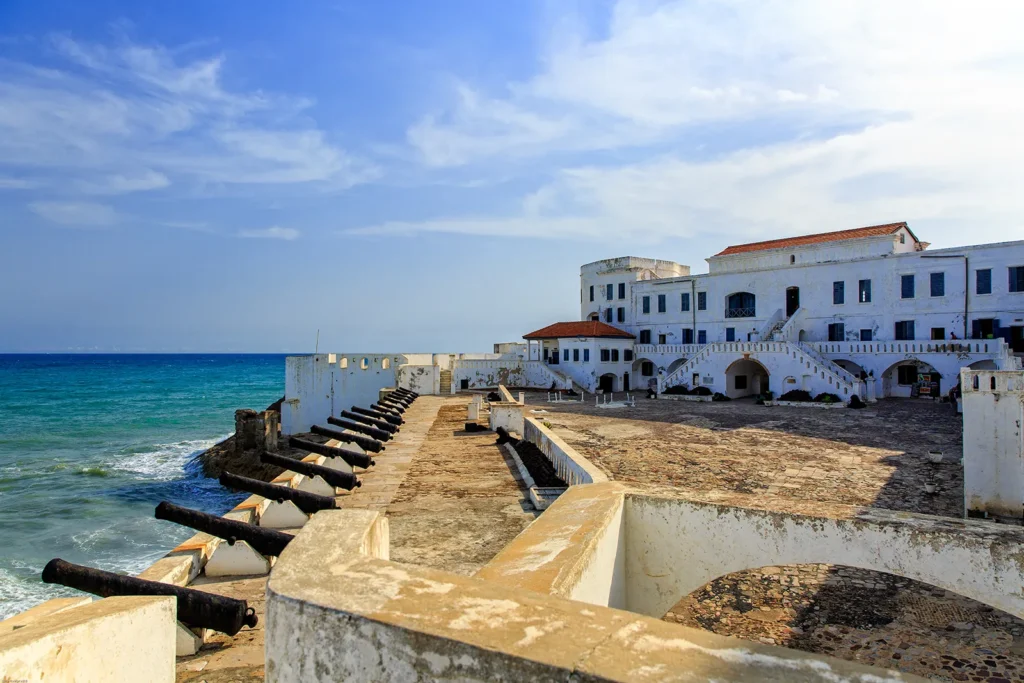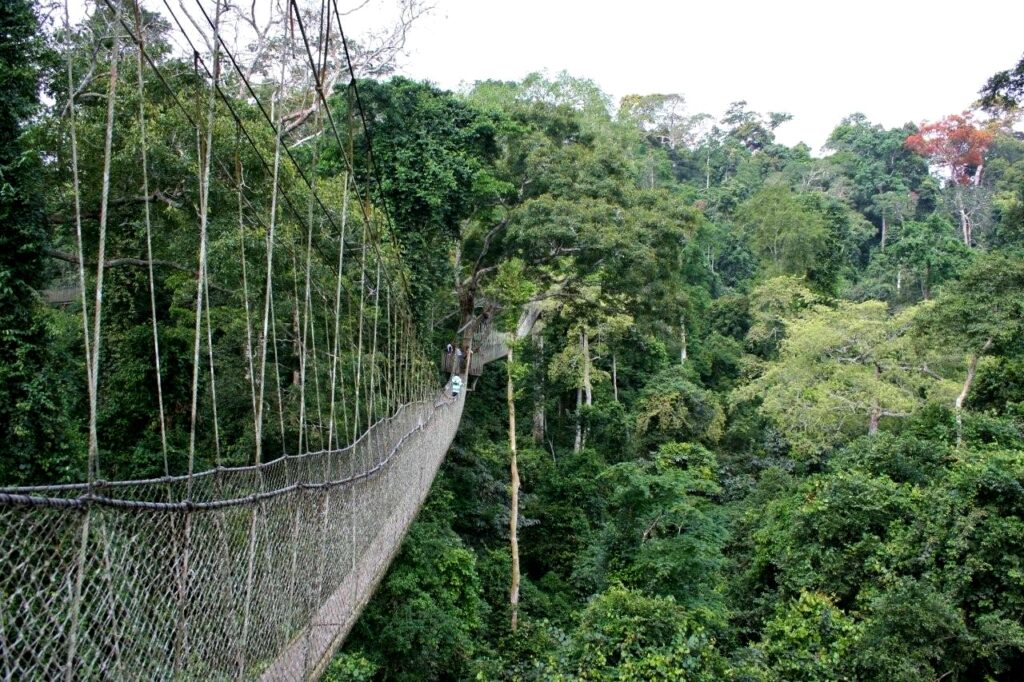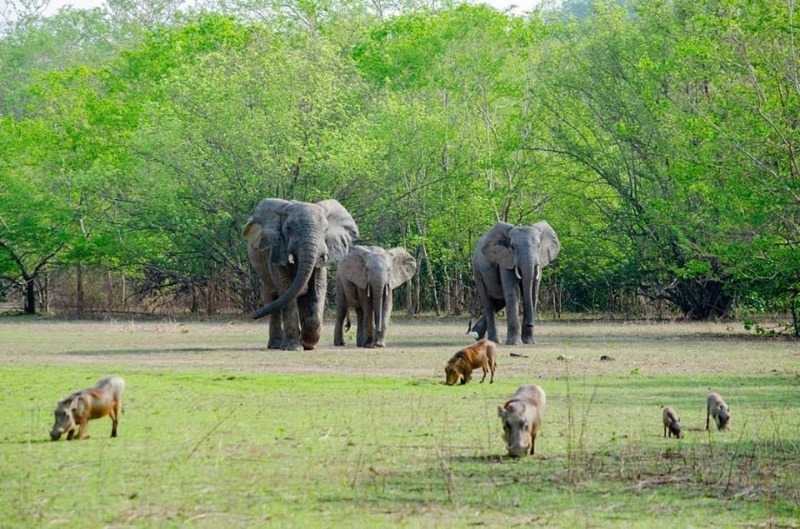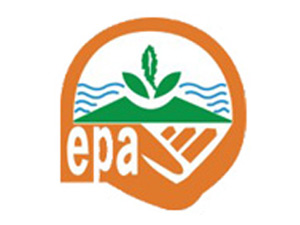Ghana provides an amazing experience, from the historic castles that evoke memories of the slave trade to the lush rainforests brimming with wildlife. The nation’s strong artistic landscape and kind hospitality make it an alluring trip destination for inquisitive minds.
The next time you decide to go on a vacation, make a stop at any of these 3 tourist sites and you will not regret it.
1. Cape Cost Castle
It’s true that Cape Coast Castle is a must-see when visiting Ghana. It truly feels as though you’ve walked into a sad history book. The transatlantic slave trade is starkly brought to memory by this UNESCO World Heritage Site. Constructed by the Portuguese in the fifteenth century, it developed into a key transatlantic hub for the transportation of enslaved persons. Although it’s not an easy experience, knowing this narrative is crucial. The castle is open for tours, and you can explore the dungeons where prisoners were kept. It’s a somber location, but you can also get a genuine feel of what transpired there because it’s now a museum. Go deeper into the history of the Cape Coast Castle:
- Portuguese Origins (1452): In an effort to establish a trading presence on the West African coast, the Portuguese built a simple trading post known as “Cabo Corso,” which translates to “Short Cape” in Portuguese. This original building served as the model for the imposing castle that still stands today.
- Transformation as a Slave Trade Hub (1650s): Cape Coast Castle changed ownership multiple times as European nations fought for control of the profitable slave trade. The fortress was expanded and fortified by the Dutch, Swedes, British, and lastly again by the British in order to house the numerous Africans held in slavery.
- The Dungeon: An Unsettling Actuality Beneath its defenses, the dungeons are the most terrifying feature of the castle. Thousands of enslaved Africans were held captive in these cramped quarters, which had poor ventilation and cleanliness as they awaited their journey over the Atlantic. Knowing what conditions captives had to live in serves as a sobering reminder of how cruel the slave trade was.
- Door of No Return: Among Cape Coast Castle’s most emblematic elements is the “Door of No Return.” The last point of contact that Africans held with their native country before being forced onto ships destined for the Americas was this entryway. A greater comprehension of the human cost of the slave trade is facilitated by reflecting on the emotional significance of this entryway.
- A Museum of Remembrance: Cape Coast Castle is a museum these days. The history of the slave trade is explored through exhibits that feature artifacts, old records, and even dungeon reconstructions. Visitors can gain a fuller appreciation of the castle’s significance in this terrible chapter of human history by participating in informative tours given by qualified guides.
A potent teaching tool, Cape Coast Castle provokes contemplation on the atrocities of the slave trade and the resiliency of the human spirit. It serves as a sobering reminder of the past, imploring us to take lessons from it and work toward a more fair and just society in the future.

2. Kakum National Park
Discover the wealth of biodiversity that awaits you at Kakum National Park, a UNESCO Biosphere Reserve and recognized Globally Important Bird Area (IBA). Situated amidst Ghana’s humid evergreen forest region, the park possesses an unparalleled ecosystem abundant with life. An examination of the following highlights why Kakum National Park is such a remarkable educational destination:
- Habitat Haven: The park includes a wide variety of forest types, ranging from marshy lowlands to high canopy rainforests. Numerous plant and animal species can find refuge in this type. This area is home to more than 700 varieties of vegetation, including colorful flowering plants, mahogany trees that reach tall heights, and strangler figs.
- Avian Paradise: Birdwatchers swarm to Kakum because of its amazing birdlife, making it an avian paradise. The park is home to over 300 different kinds of birds, some of which are globally vulnerable, such as the Yellow-bearded Greenbul and the White-necked Piculet. The park’s varied environments serve as breeding grounds for a wide variety of bird species, making it an excellent place to observe these birds’ distinctive behaviors and sounds.
- Mammalian Marvels: Though less common than avian species, Kakum National Park provides insights into the amazing realm of mammals. This park is home to shy bushbucks, elusive bongo antelopes, forest elephants, and a variety of primates, including Diana monkeys and white-collared mangabeys. During your expedition, you might come across some of these animals if you have a good eye and a little bit of luck.
- Canopy Walkway Experience: The exhilarating canopy walkway is one of the park’s most notable features. This network of seven bridges, suspended high above the forest floor, gives visitors a completely different perspective on the rainforest. Imagine being able to see the emergent trees at eye level, seeing birds flying through the branches, and sensing the refreshing mist clinging to the foliage. It’s a once-in-a-lifetime opportunity to fully comprehend the majesty and complexity of the rainforest ecology.
- Conservation Efforts: The Kakum National Park is an important location for conservation activities. Because of its protected status, the park helps maintain the delicate balance of the rainforest ecosystem and offers a safe haven for endangered animals. The park rangers’ educational activities increase public understanding of the value of sustainable development and biodiversity conservation.
Anyone with an interest in the natural world will find that visiting Kakum National Park is a rewarding educational experience. The park provides a glimpse into the delights of the Ghanaian rainforest with its distinctive canopy path and a rich range of plants and animals.

3. Mole National Park
Among Ghana’s many ecosystems, Mole National Park is the jewel in the crown, having been named a UNESCO Biosphere Reserve. Covering an area of 4,840 square kilometers, the park provides an amazing safari experience and is an important home for an amazing variety of species. Let’s examine Mole National Park’s educational relevance in more detail:
- Sudan Savanna Ecosystem: The Sudan savanna biome, a large grassland interspersed with trees and bushes, is what defines Mole National Park. A wide range of grazing and browsing species are supported by this special ecosystem, which offers the ideal mix between open plains and wooded sections. Visitors can enjoy the intricate web of life within the park by having a better understanding of the delicate balance of this environment.
- Accepting Megafauna: Mole National Park is well known for having remarkable numbers of huge creatures. Adventuresome safaris are available for tourists to hunt for famous African animals like antelopes, buffaloes, lions, and elephants. Understanding these species’ behavior, adaptations, and ecological responsibilities is enhanced by seeing them in their natural environment. A robust population of predators, including cheetahs, jackals, and hyenas, is another feature of the park that highlights the complex dynamics of the food chain.
- Avian Abundance: Mole National Park is a birdwatcher’s paradise, even beyond the presence of huge mammals. The park is home to over 300 kinds of birds, including hornbills perched on colorful branches, vultures soaring high above the plains, and elusive ground birds like bustards and guineafowls. Understanding and identifying these varied bird species offers important insights into the biodiversity of the park and the essential function that birds play in the ecosystem.
- Conservation is important, and Mole National Park is a key component in wildlife conservation initiatives. For threatened animals like the African elephant, cheetah, and hartebeest, the park offers a safe haven. Park rangers provide educational programs that increase public understanding of the dangers these creatures confront and the need of protecting their habitat.
- Possibilities for Research: Mole National Park provides an excellent setting for scientific investigation. The park’s flora and animals are studied by researchers from all over the world, who help to advance knowledge of the savanna environment and its inhabitants. Visitors are better able to appreciate the continuous attempts to preserve this special habitat when they are aware of these continuing research initiatives.
A trip to Mole National Park offers life-changing educational opportunities. It provides a window into the fascinating world of the savanna, encouraging a greater understanding of the value of protecting this unique ecosystem and the conservation of animals.

Watch out for our next list of tourist sites to visit in Ghana. Stay tuned

















